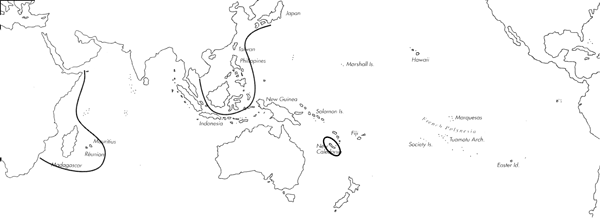
Skip Navigation Links
View access keys for this site.

Range: Known from Japan, Philippines, E. Indonesia, New Caledonia, Hawaii, South Africa, Re'union, Madagascar, and Somalia.
Description: Moderately small to medium-sized, moderately light to moderately solid. Last whorl conical; outline almost straight to moderately convex with a constriction above base. Shoulder subangulate to angulate, undulate to weakly tuberculate. Spire of low to moderate height, outline concave. Larval shell of about 4.0 whorls, maximum diameter 0.90-0.95 mm. Postnuclear spire whorls undulate. Teleoconch sutural ramps flat, with 2 increasing to 4-5 spiral grooves. Last whorl with a few faint spiral ribs at base.
| Shell Morphometry | ||
|---|---|---|
| L | 25-42 mm | |
| RW | 0.06-0.18 g/mm | |
| (L 25-38 mm) | ||
| RD | 0.56-0.64 | |
| PMD | 0.86-0.93 | |
| RSH | 0.04-0.18 | |
Colour reddish to brownish orange, occasionally yellow or light violet. Last whorl usually with a lighter band around centre, frequently interspersed with white flecks and adapically edged with brownish spots. In Philippine shells, uniform colouration often replaced by dark and light clouds above centre; white axial streaks below shoulder and across central band. Larval whorls orangish pink to faint yellow. Teleoconch sutural ramps variably maculated with darker yellow, pink or orange axial blotches. Aperture translucent.
Periostracum yellowish brown to brown, thin, translucent to opaque, and velvety smooth or with tufted spiral lines around last whorl (Kohn & Weaver, 1962; as "C. sp. cf. C. cumingii Reeve").
In Hawaii, foot buff, mottled with light tan, tinged with vermilion at its extremities. Rostrum and tentacles pale buff. Siphon light vermilion, mottled with small darker blotches (Kohn & Weaver, 1962). Radula teeth with an adapical barb opposed to a long blade; serration with coarse denticles from the end of the barb to the center of the shaft; base with a spur (Rola'n, personal observation, 1992).
Habitat and Habits: Reported from depths between 50 and 200 m; in Hawaii, mainly on coral rubble.
Discussion: C. sazanka is quite distinct from its Indo-Pacific congeners; for comparison with C. lischkeanus see DISCUSSION of this species. Shells of C. sazanka from Japan and South Africa are very similar to each other and are strikingly uniform in colour pattern. Philippine specimens are more variable in colouration and pattern, even at the same locality; differences in shape or sculpture cannot be observed. Hawaiian shells vary both in colour (yellow to deep orange) and in sculpture of the last whorl ("partly or entirely encircled by granular spiral lirae;" Kohn & Weaver, 1962; as "C. sp. cf. C. cumingii Reeve"). However, colour and sculptural variants appear to co-occur. The colour pattern variability observed in Hawaii closely matches that known from Philippines.

C. sazanka Range Map
This section contains verbatim reproductions of the accounts of 316 species of Conus from the Indo-Pacific region, from Manual of the Living Conidae, by Röckel, Korn and Kohn (1995). They are reproduced with the kind permission of the present publisher, Conchbooks.
All plates and figures referred to in the text are also in Röckel, Korn & Kohn, 1995. Manual of the Living Conidae Vol. 1: Indo-Pacific Region.
The range maps have been modified so that each species account has it own map, rather than one map that showed the ranges of several species in the original work. This was necessary because each species account is on a separate page on the website and not confined to the order of accounts in the book.
Return to framed version (returns to search page)